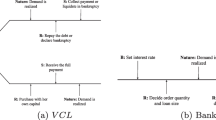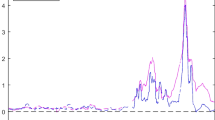Abstract
Banks often control their risks to be below a risk limit through setting a loan limit and the capital constrained newsvendor can make the loan limit increase by buying a guarantee insurance policy. This paper examines the impact of a bank’s risk limit, interest rate setting and initial capital on the newsvendor’s financial and ordering decisions with deductible insurance contract. In the perfectly competitive bank market, it is shown that the newsvendor will restore his profit to the optimal level without capital constraint by buying a full insurance. In the regulated monopolistic bank market, the newsvendor only buys insurance when both his initial capital and the bank’s risk limit are low; for a poorer newsvendor, the bank should require a lower risk limit to force the newsvendor to buy insurance, not just to meet regulatory requirements. It is also shown that the insurance is more useful for a poor newsvendor and a more risk-averse bank.







Similar content being viewed by others
References
Anderson MH, Prezas AP (1998) The interaction of investment and financing decisions under moral hazard. Int Rev Econ Financ 7(4):379–392
Buzacott JA, Zhang RQ (2004) Inventory management with asset-based financing. Manag Sci 50(9):1274–1292
Cai G, Chen X, Xiao Z (2014) The roles of bank and trade credits: theoretical analysis and empirical evidence. Prod Oper Manag 23(4):583–598
Caillaud B, Dionne G, Jullien B (2000) Corporate insurance with optimal financial contracting. Econ Theor 16(1):77–105
Chen X, Cai G, Song J (2019) The cash flow advantages of 3PLs as supply chain orchestrators. Manuf Serv Oper Manag 21(2):435–451
Dada M, Hu QH (2008) Financing newsvendor inventory. Oper Res Lett 36:569–573
Deng S, Gu C, Cai G et al (2018) Financing multiple heterogeneous suppliers in assembly systems: Buyer finance vs. bank finance. Manuf Serv Oper Manag 20(1):53–69
Devalkar SK, Krishnan H (2019) The impact of working capital financing costs on the efficiency of trade credit. Prod Oper Manag 28(4):878–889
Dong L, Tomlin B (2012) Managing disruption risk: the interplay between operations and insurance. Manag Sci 58(10):1898–1915
Dotan A, Ravid SA (1987) On the interaction of real and financial decisions of the firm under uncertainty. J Financ 40(2):501–507
Gollier C (1996) Deductible insurance and production: a comment. Insur Math Econ 19:55–59
Jing B, Chen X, Cai G (2012) Equilibrium financing in a distribution channel with capital constraint. Prod Oper Manag 21(6):1090–1101
Kouvelis P, Zhao W (2011) The newsvendor problem and price-only contract when bankruptcy costs exist. Prod Oper Manag 20(6):921–936
Kouvelis P, Zhao W (2012) Financing the newsvendor: Supplier vs. bank, and the structure of optimal trade credit contracts. Oper Res 60(3):566–580
Lai G, Debo LG, Sycara K (2009) Sharing inventory risk in supply chain: the implication of financial constraint. Omega 37(4):811–825
Lariviere M, Porteus E (2001) Selling to the newsvendor: an analysis of price-only contracts. Manuf Serv Oper Manag 3(4):293–305
Machnes Y (1995) Deductible insurance and production. Insur Math Econ 17:119–123
Machnes Y, Wong K (2003) A note on deductible insurance and production. Geneva Pap Risk Insur Theor 28:73–80
Modigliani F, Miller M (1958) The cost of capital, corporation finance and the theory of investment. Am Econ Rev 48(3):261–297
Myers SC (1974) Interaction of corporate financing and investment decisions–implications for capital budgeting. J Financ 29:1–25
Myers SC (1977) Determinants of corporate borrowing. J Financ Econ 5:147–176
Reindorp M, Tanrisever F, Lange A (2018) Purchase order financing: credit, commitment, and supply chain consequences. Oper Res 66(5):1287–1303
Serpa J, Krishnan H (2017) The strategic role of business insurance. Manag Sci 63(2):384–404
SGI Website (2019). https://www.sgic.co.kr/chp/iutf/en/html/Products.mvc?tm=2&sm=1
Stiglitz JE (1972) Some aspects of the pure theory of corporate finance: bankruptcies and take-overs. Bell J Econ Manag Sci 3:458–482
Tang CS, Yang SA, Wu J (2018) Sourcing from suppliers with financial constraints and performance risk. Manuf Serv Oper Manag 20(1):70–84
Tunca TI, Zhu W (2018) Buyer intermediation in supplier finance. Manag Sci 64(12):5631–5650
Xu X, Birge JR (2008) Operational decisions, capital structure, and managerial compensation: a news vendor perspective. Eng Econ 53:173–196
Yang SA, Bakshi N, Chen C (2019) Trade credit insurance: operational value and contract choice. Working paper, London Business School
Zhang Y, Huang S, Yang SA (2019) Financing inventory under bank capital regulation and seller orchestration. Working paper, Tsinghua University
Zhou W, Lin T, Cai G (2017) Guarantor financing in a four-party supply chain with leadership influence. Working paper, Santa Clara University
Acknowledgements
This work is supported by the Natural Science Foundation of China Grant 71402112, the Program for the Philosophy and Social Sciences Research of Higher Learning Institutions of Shanxi Grants 201801030 and 201803089, the Program for the Soft Science of Shanxi Grant 2017041012-1, and the Program for the Scientific Activities of Selected Returned Overseas Professionals in Shanxi Province Grant 2019047.
Author information
Authors and Affiliations
Corresponding author
Additional information
Publisher's Note
Springer Nature remains neutral with regard to jurisdictional claims in published maps and institutional affiliations.
Appendix
Appendix
Proof of Proposition 1
Define \(A = (1 - \alpha )(wQ + m(b) - B)\), we have \(A < pz(Q,b)\) always holds. If the newsvendor borrows money, the bank’s risk is as follows (Fig. 8):
-
1.
If \(\frac{A}{p} < \frac{b}{p}\), that is, \(Q < \frac{B}{w} + \frac{b}{w(1 - \alpha )} - \int_{0}^{{\frac{b}{p}}} {\frac{p}{w}F(x)dx} \equiv Q_{2} (b)\), we have \(\Pr \{ Y(Q,b) \le A\} = 0\), which means the bank can control risk all the time.
-
2.
If \(\frac{A}{p} \ge \frac{b}{p}\), that is, \(Q \ge \frac{B}{w} + \frac{b}{w(1 - \alpha )} - \int_{0}^{{\frac{b}{p}}} {\frac{p}{w}F(x)dx} \equiv Q_{2} (b)\), we have \(\Pr \{ Y(Q,b) \le A\} = F\left( {\frac{b}{p}} \right) + \Pr \left( {\frac{b}{p} < \xi < \frac{A}{p}} \right) = F\left( {\frac{A}{p}} \right)\). Thus, \(F\left( {\frac{A}{p}} \right) \le \beta\), that is, \(Q \le \frac{{B{ + }L(\beta )}}{w} - \int_{0}^{{\frac{b}{p}}} {\frac{p}{w}F(x)dx} \equiv Q_{3} (b)\), must hold to control the bank’s risk.
It is easy to see that \(Q_{2} (b)\) increases with \(b\), \(Q_{3} (b)\) decreases with \(b\). Because \(Q_{2} (0) < Q_{3} (0)\), there exists a unique insurance coverage level \(b_{0} = pF^{ - 1} (\beta )\), such that the newsvendor’s order limit is \(Q_{3} (b)\) for \(b \le b_{0}\) and \(Q_{2} (b)\) for \(b > b_{0}\).
Proof of Lemma 1
Because \(Q_{2} (b_{1} ) = \frac{{B{ + }L(\beta )}}{w}\), we have (10) holds. Using the Implicit Function Theorem of (10), we have
Thus, \(b_{1}\) increases with \(\beta\).
Proof of Proposition 2
When the newsvendor borrows money from the bank, the bank’s risk can be defined as
Thus, the bank will set the loan limit to let the newsvendor’s order limit equal \(Q_{1}\). Because \(Q_{1}\) increases with \(B\), the bank’s risk control does not work if \(L(\beta ) \ge wQ^{N}\). If \(L(\beta ) < wQ^{N}\), the newsvendor’s optimal order quantity is \(Q^{*} = \hbox{min} (Q_{1} ,Q^{N} )\).
Proof of Lemma 2
Define
Based on Implicit Function Theorem, we have
which implies the results.
Proof of Proposition 4
If the newsvendor borrows money, the bank’s risk is the same as that in the perfectly competitive bank market. Thus, the bank will set the loan limit such that the newsvendor’s order limit is \(Q_{1}\). Using the Implicit Function Theorem of (14), we have
Thus, \(Q^{LO}\) decreases with \(B\). When \(B = wQ^{M}\), \(Q^{LO} = Q^{M}\), so \(Q^{LO} > Q^{M}\) for \(B < wQ^{M}\).
Because \(Q_{1}\) increases with \(B\), the bank’s risk control constraint does not work if \(L(\beta ) \ge wQ_{ 0}^{LO}\). If \(L(\beta ) < wQ_{ 0}^{LO}\), when \(B = wQ^{M}\), \(Q^{LO} = Q^{M} < Q_{1}\), so there exists a unique \(B_{0} \in (0,wQ^{M} )\) satisfies \(p[1 - F(Q_{1} (B_{0} ))] = w(1 + r)[1 - F(z(Q_{1} (B_{0} )))]\) such that \(Q^{LO} > Q_{1}\) for \(B < B_{0}\) and \(Q^{LO} < Q_{1}\) for \(B > B_{0}\). Besides, the conclusion that \(B_{0}\) decreases with \(\beta\) can be easily obtained from Lemma 5.
Proof of Lemma 3
The first-order derivatives of \(\varPi_{M}^{LI} (Q,b)\) with respect to \(b\) and \(Q\) are
Given \(b\), \(\frac{{\partial \varPi_{M}^{LI} (Q,b)}}{\partial Q}\) decreases with \(Q\) at \(Q = Q^{LI} (b)\).
Using the Implicit Function Theorem of (17), we have
Thus, \(Q^{LI} (b)\) increases with \(b\).
Proof of Lemma 4
For \(B < B_{0}\),
Because
Both \(\varPi_{M}^{LI} (Q_{3} (b),b)\) and \(\varPi_{M}^{LI} (Q^{LI} (b),b)\) decrease with \(b\).
Because\(\frac{{d\varPi_{M}^{LI} (Q_{2} (b),b)}}{db} = p[1 - F(Q_{2} (b))]\left[ {\frac{1}{w(1 - \alpha )} - \frac{1}{w}F\left( {\frac{b}{p}} \right)} \right] - \left[ {1 - F\left( {\frac{b(1 + r)}{p(1 - \alpha )}} \right)} \right]\frac{1 + r}{1 - \alpha }\), and \(b^{S}\) satisfies the first-order optimality condition,
From (21), we can see that \(\frac{1}{w(1 - \alpha )} - \frac{1}{w}F\left( {\frac{{b^{S} }}{p}} \right) \ge \frac{1 + r}{p(1 - \alpha )}\) holds since \(Q_{2} (b^{S} ) \ge z(Q_{2} (b^{S} ),b^{S} ) = \frac{{b^{S} (1 + r)}}{p(1 - \alpha )}\). Thus, \(\left. {\frac{{d^{2} \varPi_{M}^{LI} (Q_{2} (b),b)}}{{db^{2} }}} \right|_{{b = b^{S} }} < 0\) which means \(\varPi_{M}^{LI} (Q_{2} (b),b)\) is concave and obtains the maximal value in \(b = b^{S}\).
Using the Implicit Function Theorem of (21), we have
Because \(Q_{2} (b^{S} ) \ge z(Q_{2} (b^{S} ),b^{S} ) = \frac{{b^{S} (1 + r)}}{p(1 - \alpha )}\) and \(\frac{1}{w(1 - \alpha )} - \frac{1}{w}F\left( {\frac{{b^{S} }}{p}} \right) \ge \frac{1 + r}{p(1 - \alpha )}\), \(\frac{{db^{S} }}{dB} < 0\) always holds.
Define \(H(b) = \frac{{d\varPi_{M}^{LI} (Q_{2} (b),b)}}{db}\) and we have
Thus, \(b^{S} < b_{2}\) holds. Similarly, we have \(H(0) = p\left[ {1 - F\left( {\frac{B}{w}} \right)} \right]\frac{1}{w(1 - \alpha )} - \frac{1 + r}{1 - \alpha }\). When \(B < B_{0}\), we have \(B < wQ^{M}\), \(H(0) > 0\). Thus, \(b^{S} > 0\) holds.
Proof of Lemma 5
The first-order derivative of \(\varPi_{M}^{LO} (Q_{ 1} )\) with respect to \(\beta\) is
where
\(\beta_{1}\) is the solution of \(G(\beta ) = 0\). Because
we have
Thus, \(\varPi_{M}^{LO} (Q_{1} )\) obtains the maximal value at \(\beta = \beta_{1}\). Using the Implicit Function Theorem of (22), we have
Thus, \(\beta_{1}\) decreases with \(B\). When \(B = wQ^{M}\), \(\beta_{1} = 0\), so \(\beta_{1} > 0\) for \(B < B_{0}\) since \(B_{0} < wQ^{M}\).
Proof of Proposition 7
When \(\beta = 0\), let
and we have
Thus, \(T(B)\) increases with \(B\). When \(B = wQ^{M}\), \(b^{S} = 0\), so \(T(B) = 0\). Thus, \(T(B) < 0\) always holds for \(B < B_{0}\) since \(T(0) < 0\) and \(B_{0} \le wQ^{M}\). That is to say, \(\varPi_{M}^{LO} (Q_{1} ) < \varPi_{M}^{LI} (Q_{2} (b^{S} ),b^{S} )\) holds for \(\beta = 0\).
When \(\beta = \beta_{1}\), i.e. \(B = B_{0}\), \(Q_{ 1} = Q^{LO}\), so we have
Because \(\varPi_{M}^{LI} (Q_{2} (b^{S} ),b^{S} )\) is independent of \(\beta\) and \(\varPi_{M}^{LO} (Q_{1} )\) increases with \(\beta\) for \(B < B_{0}\), there exist a unique value \(\beta_{2} \in (0,\beta_{1} )\), such that \(\varPi_{M}^{LO} (Q_{1} ) < \varPi_{M}^{LI} (Q_{2} (b^{S} ),b^{S} )\) for \(\beta < \beta_{2}\) and \(\varPi_{M}^{LO} (Q_{1} ) > \varPi_{M}^{LI} (Q_{2} (b^{S} ),b^{S} )\) for \(\beta < \beta_{2}\).
Rights and permissions
About this article
Cite this article
Wang, W., Zhang, Q. Financing the newsvendor: raising the loan limit by insurance contract. Oper Res Int J 21, 2907–2932 (2021). https://doi.org/10.1007/s12351-019-00526-9
Received:
Revised:
Accepted:
Published:
Issue Date:
DOI: https://doi.org/10.1007/s12351-019-00526-9





